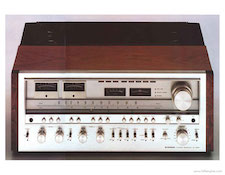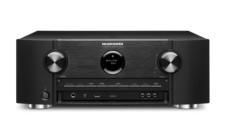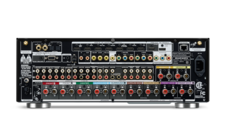It’s the time of year for saving money!
Back in the “golden age” of high-end audio hardly a month went by that you couldn’t find and read a negative review in The Absolute Sound or Stereophile which excoriated a particular manufacturer’s newest offering. Nowadays it’s hard to find an equipment review that doesn’t describe its subject in glowing terms. What’s changed?
 As someone who’s experienced their fair share of good, bad, and occasionally great vintage audio components, I think that the reason is quite simple – currently available audio components offer a far fewer models that deliver a truly bad value. In the olden, golden times, that was not the case. Also old-school audiophiles had a much higher tolerance for less-than-stellar reliability. Need I mention Audio Research’s series of preamplifiers that needed to be “revised” from A to B to C versions before they worked reliably?
As someone who’s experienced their fair share of good, bad, and occasionally great vintage audio components, I think that the reason is quite simple – currently available audio components offer a far fewer models that deliver a truly bad value. In the olden, golden times, that was not the case. Also old-school audiophiles had a much higher tolerance for less-than-stellar reliability. Need I mention Audio Research’s series of preamplifiers that needed to be “revised” from A to B to C versions before they worked reliably?
But you would not know this from reading a recent article in Gizmodo by Adrian Covert titled “Why Your Dad’s 30-year-old Stereo is Better Than Your New One” the author puts forward the idea that new receivers are inferior to 30-year-old ones. But during the article the writer hedges his bets by comparing a current-production $500 receiver with a 1980 $500 receiver. If he wanted to compare apples to apples instead of apples to pureed applesauce he should have compared a 30-year-old $500 receiver with a $1400 receiver since that is what $500 in 1980 would be priced at in today’s dollars.
 When you compare a typical $500 1980 receiver with a current offering you’ll see that there’s lots of sonic reasons to consider buying new. Take the $1399 MSRP Marantz SR6010, which is Marantz’s second to the top-of-the-line model. Besides offering far more input options, including Bluetooth, WiFi, DLNA, and Airplay compatibility, this receiver has a Marantz’s HDAM audio output circuit topology, which is not merely an Op amp integrated circuit. The SR6010 also includes Audessey processing to help correct for room-based sonic anomalies. There’s nothing even remotely like this available in a 30-year-old receiver. And, if used properly, Audessey can vastly improve the sound in a multi-use environment in ways that can’t be achieved by a 30-year-old receiver regardless of its make, price, or purported sonic excellence.
When you compare a typical $500 1980 receiver with a current offering you’ll see that there’s lots of sonic reasons to consider buying new. Take the $1399 MSRP Marantz SR6010, which is Marantz’s second to the top-of-the-line model. Besides offering far more input options, including Bluetooth, WiFi, DLNA, and Airplay compatibility, this receiver has a Marantz’s HDAM audio output circuit topology, which is not merely an Op amp integrated circuit. The SR6010 also includes Audessey processing to help correct for room-based sonic anomalies. There’s nothing even remotely like this available in a 30-year-old receiver. And, if used properly, Audessey can vastly improve the sound in a multi-use environment in ways that can’t be achieved by a 30-year-old receiver regardless of its make, price, or purported sonic excellence.
 There is one particular area where a 30-year-old receiver will beat ANY new receiver – it will discounted far more than a new one. And it should be. Chances are you’ll find plenty of $300 to $500 30-year-old receivers at your local Good Will or Salvation Army resale store. Every time I dropped into one of the large stores in Denver I’ve seen multiple receivers available – all for less than $100. But remember that most 30-year-old electronics does need some refurbishing for reliability and best sound to insure that the capacitors aren’t leaky and none of the resistors in critical locations are going bad. So you need to factor in repair or refurbishment costs with any older piece of HiFi gear you purchase if your goal is a reliable and optimal sounding piece of gear. Your initial $100 spent can easily balloon into $200, $300, or even $500 in repair and refurb costs. So, unless you find a receiver that a repairman has for sale (that they have already had potentially failing parts replaced) you really have no idea how much that under $100 receiver will really cost you – you could very well wind up with the option of either a $100 boat anchor or $600 in sunk costs for a piece of gear that you’ve never even heard yet.
There is one particular area where a 30-year-old receiver will beat ANY new receiver – it will discounted far more than a new one. And it should be. Chances are you’ll find plenty of $300 to $500 30-year-old receivers at your local Good Will or Salvation Army resale store. Every time I dropped into one of the large stores in Denver I’ve seen multiple receivers available – all for less than $100. But remember that most 30-year-old electronics does need some refurbishing for reliability and best sound to insure that the capacitors aren’t leaky and none of the resistors in critical locations are going bad. So you need to factor in repair or refurbishment costs with any older piece of HiFi gear you purchase if your goal is a reliable and optimal sounding piece of gear. Your initial $100 spent can easily balloon into $200, $300, or even $500 in repair and refurb costs. So, unless you find a receiver that a repairman has for sale (that they have already had potentially failing parts replaced) you really have no idea how much that under $100 receiver will really cost you – you could very well wind up with the option of either a $100 boat anchor or $600 in sunk costs for a piece of gear that you’ve never even heard yet.
So, if you want to try going the 1980 receiver route, at least now you have a better idea about the potential pitfalls of your plan…






Great review except that there was no mention of sound quality, to me that’s more important than bells and whistles.
Yep — if your criteria comes down to only additional functionality (often focused on home theater), then sure, modern receivers add things the vintage doesn’t have. But the reality for most people who want to listen to music is that the vintage 80’s receivers are very hard to beat from a sound quality perspective.
Then take it a step further and figure out how many of those modern receivers can adequately drive 4 ohm speakers…
There are some reasons to like modern receivers, but to say the vintage ones “suck” is idiotic. An NAD 7400 or even 7100 or even 7150 paired with some KEF speakers will blow away almost every modern receiver up to a very high price point in today’s market
The new Marantz stuff is pure junk and measurers horribly, seen it on audio science review, even the new pioneer avrs suck and measure horribly, a freshly recapped pioneer vsx 454 from 1995 or even a 2 channel sx 980 1250 1980 from the 70s and early 80s would beat the piss out of anything newer, they are rated both channels driven from 20hz to 20khz. Most things are measured at 1khz at 1 to 10 percent thd these days which is the biggest bs power figure you can imagine… Things aren’t what they used to be, so yes, fully restored vintage gear will destroy newer avrs in every way unless you are Willing to pay a lot of cash for a newer amplifier or even a decent pro Amp like a qsc rmxa adcom bryston ect, then thats a different story, these days most of the time youll get junk, most avrs are horrible and focus to much on bells and whistles instead of Sq and build quality. Really dennon makes the only decent avrs anymore and even then it wouldn’t hold a candle to my 454… Audio science review has said dennons are still decent, they measure better then most avrs today, so yup that other article was correct lmao.
Two pieces of gear from the same manufacturer does not a trend make…and please do some math…price adjust your comparisons…and once again reading comprehension issues…take a $220 SMSL…it will kill your vintage stuff even on ASR…